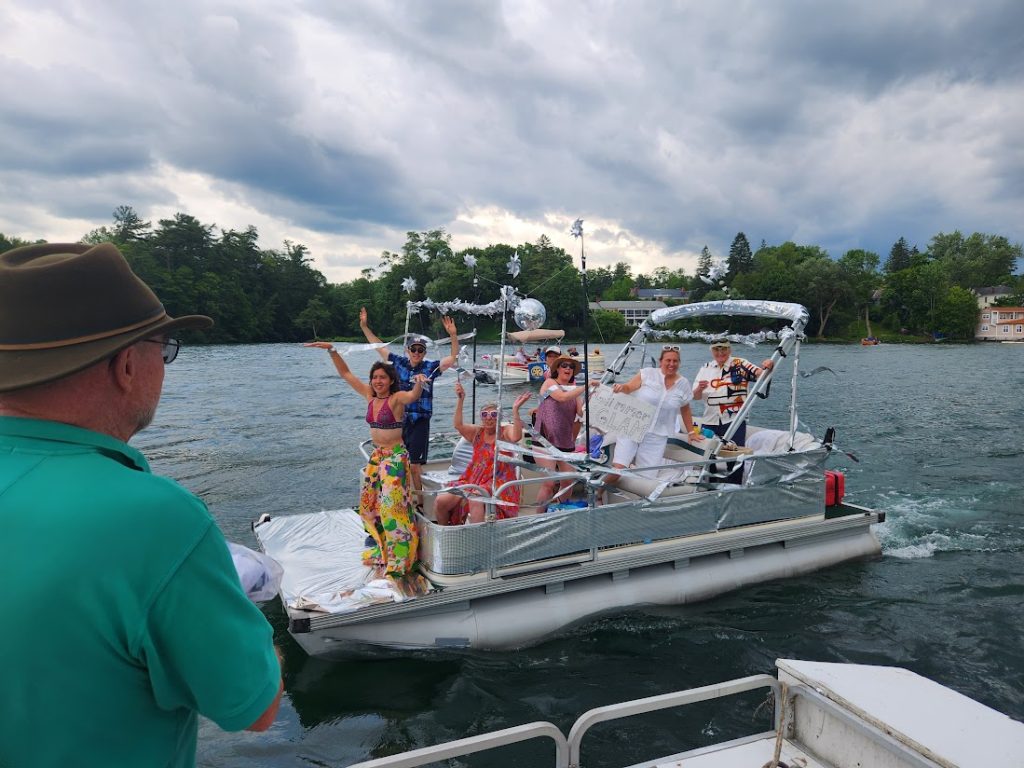
Flying Boat, 30 Families Join OLA Parade
By WRILEY NELSON
COOPERSTOWN
The Otsego Lake Association held its annual “We Love Our Lake” Boat Parade at 3 p.m. on Monday, July 3. At least 30 boats participated in the decoration contest, with many more joining for part of the route or observing from the sidelines. This year’s parade had a special guest participant, Geoff Nye, who flew in to follow the lineup in his flying boat, “The Buccaneer.” The parade lined up near Three Mile Point and processed slowly past Sam Smith’s Boatyard, the Otsego Sailing Club and the Cooperstown Country Club before ending near Lakefront Park.
Nye was one of five winning participants to receive a bag of OLA merchandise for their efforts. Robert Nelson and Van Ramsey, the Tom and Kathy Chase family, the Ed and Joan Bagley family, and Barbara Lecourt also won. All of them are Cooperstown or Town of Otsego residents. Each participating boat received a bag of candy and boat decontamination kit to prevent the spread of invasive species.
Competition judges led the parade in the SUNY Oneonta Biological Field Station barge, the Anodontoides. The barge, named for a genus of freshwater mussels, is the BFS’ primary craft for research and public service. It was piloted by Lt. Col. Paul Lord, a SUNY Oneonta biology lecturer and BFS researcher and dive master. Lord has five decades of experience on Otsego Lake and reflected on diving challenges, underwater archaeological finds and ongoing ecological threats throughout the outing.
“I was a college intern with [long-serving BFS Director] Bill Harman in 1972 when we built this,” he recalled, gesturing to the barge’s A-frame pulley apparatus for taking samples. “He had me carry this redwood lumber down to the dock with no explanation, then sat down and built this thing in an afternoon with no instructions or plans. We’ve only had to replace one piece.”
The barge stopped en route to examine the automated lake monitoring buoy. This research station, overseen by Dr. Kiyoko Yokota, collects 46 weather and water-quality measurements, ranging from the surface to the full 160-foot depths at the lake’s deepest point. Data are collected at 15-minute intervals 24 hours a day throughout the open-water season.
“We installed the full station for the entire season starting in 2017, with help from the National Science Foundation,” Yokota said after checking the buoy. “Most of our data collection is weekly or less often. This high-frequency data is absolutely critical to understanding water movement and it’s become a big part of our HAB tracking project.”
“Unfortunately, the NSF only covered installation,” Yokota continued. “The university’s departmental budgets are annual, so it’s very difficult to cover any kind of major repair or maintenance job. We’ve mostly been relying on donations to or through the OLA.”
Lord, who oversees the dive teams that install and remove the no-wake zone buoys surrounding the lake, can point out the depth of each buoy and provide an anecdote about its installment from memory. BFS has run the no-wake program for more than 15 years. Vessels must slow to five miles per hour when they are within 200 feet of the shore; wakes that disturb lakeside soil are an easily-preventable source of excess nutrients that cause harmful algal blooms. Despite the major dive-team work to install the reminder buoys, Lord noted that many boaters ignore them due to the negligible law enforcement presence on the lake.
“When we started the buoy program, many people intentionally tried to sink them,” he recalled. “They ran them over, tried to puncture them with tools, painted them, taped up the warning lights.”
Over the course of the parade, several BFS and OLA members had to gently remind participant and spectator boats about the no-wake zone.
The BFS researchers spoke in somber tones about the lake’s future. Another large-scale HAB is very likely this season and all but certain to recur in the next few years.
“We predicted for over five years that Otsego Lake could start suffering from HABs if [invasive] quagga mussels were introduced. That’s exactly how it went in the Great Lakes and Finger Lakes,” Lord said. “We found the first one in 2019. In 2021, I measured 40 quaggas in a square meter. Last year it was 250. This year, I expect they’ll be beyond counting; I’ll be talking in terms of percentage of the study area covered.”
“Each of those mussels is filtering a gallon of water a day,” he explained. “A lot of people say they like the clearer water, but they’re literally sucking the life out of the lake. They selectively spit out the harmful [HAB-causing] cyanobacteria while removing all the competing species.”
Lord touched on the threat of inadequate sewage treatment, a major source of excess nutrients.
“Canadarago Lake has a much longer history with HABs and a lot more harmful species than Otsego,” he said. “There are all the camps over there with private septic tanks that flood like clockwork every spring and fill the lake with sewage. I had thought that meeting last month to propose a public sewer line was pro forma and that it would be approved, but there was a lot of pushback on tax concerns. They should know that they’re running their existing wastewater plant at a massive loss because it’s so far under capacity. A new line could save a lot of unnecessary personnel costs.”
Well over 100 people participated in the parade directly and large crowds looked on from the Country Club and Lakefront. Wayne Bunn, chairman of the OLA Boat Parade Committee, thanked the Otsego County Sheriff Department’s Marine Patrol for remaining on standby for safety concerns. The parade was a great show of support and appreciation for an endangered lake and its beauty. Whether that appreciation is strong enough for boaters, taxpayers, property owners and municipalities to lift a finger in its defense is anyone’s guess.

